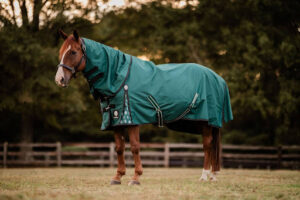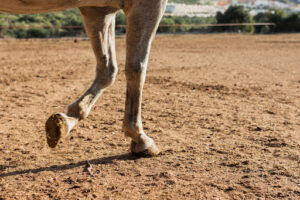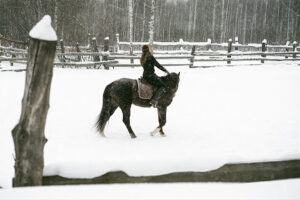Flying Changes 101: Riding Guide and Top Tips
Flying changes (or changing the canter lead without transitioning down from the canter) are one of those really cool riding tricks that everyone wants to do. If you’re a dressage rider, you’ll have to start showing them in competition at third level. If you’re a jumper, you’ll find that adding good changes to your riding […]

Flying changes (or changing the canter lead without transitioning down from the canter) are one of those really cool riding tricks that everyone wants to do. If you’re a dressage rider, you’ll have to start showing them in competition at third level. If you’re a jumper, you’ll find that adding good changes to your riding repertoire gives you tons more options as you ride round a course.
Flying changes are quite a common stumbling block in horse training. Both horse and rider can struggle with the concept of introducing changes. And even if one member of the partnership is quite well established and has done flying changes before, they’re not always easy to ride on every horse.
Plus, they’re a good test of whether your horse is truly on the aids and connected to the bridle. When they’re added into a proper schooling regime, they can be a useful way to help your horse develop straightness and engagement.
What You Should Know Before You Start Flying Changes
It’s not recommended to jump straight into the changes unless your horse is completely ready. The changes are often hard for a horse both physically and mentally. Asking before both of you are ready is likely to lead to confusion on the part of the horse, and frustration for both of you.
Here are a few things to consider before you start working on the changes themselves.
Counter Canter or Flying Changes First?
There’s a debate about whether horses should learn counter canter or flying changes first. Usually, dressage riders will say counter canter. It comes up earlier in dressage tests, and often horses need to perform a flying change out of counter canter and into true canter. Also, being able to ride a good counter canter is generally a good indication that the true canter is balanced and engaged.
That said, jumping riders will often say flying changes should come first. Jumping horses don’t need to perform counter canter at shows, and a horse learning how to do good changes means you’ll have a smoother round with a better rhythm. If your horse is jumping a reasonable height, it may be more important to you that they learn changes rather than counter canter.
Personally, I always teach the counter canter first and find that it is a good litmus test of whether the horse is strong and balanced enough to do changes. Plus, the counter canter is an excellent training tool to develop straightness and collection. Regardless though, your goal should be to have both of them well established eventually – even if just to ensure that your horse is listening to your aids and isn’t just changing leg whenever you change direction.
Simple Changes
Before you start on flying changes, your horse should be able to change leg through both the trot and canter easily. If they can’t do this, they won’t have enough balance and engagement to do a proper flying change and will probably either fall into trot or do a change which is late behind. Read our guide on simple changes here.
Being able to change through the walk and trot with only a couple of strides at the lower gait also means that your horse understands the purpose of the seat and leg aids, and can balance their canter enough to perform a canter to walk transition without becoming hollow, resistant, or tense.

Ways to Incorporate Flying Changes into a Ride
Because flying changes can really be used to change lead in any setting, there are quite a few ways you can ride them. Some common places you’ll see them, either in dressage tests or in schooling exercises include:
- Across either a long or short diagonal (single or tempi changes)
- At D, L, I, or G when turning from the marker at the long side of the arena and riding straight across the short side.
- Across the center line when riding a serpentine
- In the corner after an extended canter
- On the rail of the arena from counter canter into true canter
- On the centerline
- In the middle of a figure 8
- On a straight line after a jump
Of course, this isn’t every instance in which you might see a flying change – just some of the more common ones. To be honest, you can incorporate them almost anywhere in order to help develop your horse or address a specific problem.
The Aids for Riding Good Flying Changes
If you are riding a flying change, it’s easy to get confused as to what leg and rein and hip goes where. After all, it happens pretty quickly! To simplify it, just remember that you use the same aids as you would for a walk-canter transition.
For example, in a change from the left lead to the right lead:
- Keep your horse as straight as possible, then change the flexion slightly so the horse is flexed to the new inside (the right) rein, without pulling back on the rein.
- Use your new outside rein (left rein) to keep the connection
- Use your new outside leg (your left leg) slightly behind the girth to tell your horse to strike off with the new outside hind leg.
- Push your new inside seat bone (right) forward toward your horse’s right ear.
- Keep your inside leg on to make sure your horse stays engaged and travels forward rather than hopping on the spot
Remember, these all happen within the space of one stride, so almost simultaneously. It’s important that your horse is completely reactive to the aids – if he isn’t in front of your leg or doesn’t accept the rein, he may end up changing “late behind” (where the front leg changes first and the back leg changes a stride or more later) which can be hard to correct.
If all has gone to plan in your schooling so far, your horse might latch on to the changes quite easily, especially if the canter is balanced and good quality. But don’t expect it all to go smoothly. Even with well-established canters and good riders, it doesn’t always come naturally for all horses. During the learning process, a horse who struggles could offer a range of reactions – they could get hot and strong, try to buck, or back off the leg entirely and not offer the change at all.
Some horses do take longer to “get” the changes than others, as do some riders. If you’re struggling, what can you do to help get them right?
Tips to Get Clean Flying Changes
Flying changes, even for experienced riders, can be one of the hardest things to teach a horse. The most common problem is when the horse is late behind. Another often-encountered error is when the horse goes crooked and changes by swinging his quarters to the side rather than stepping more underneath himself.
And there are also horses who are late on the aids – who only do the changes a stride (or more) after you ask. This isn’t such a problem in horses still learning, but becomes tricky when you need to ask in a specific spot or have to do tempi changes.
And of course, there are the usual possibilities: the horse becoming hollow, resistant, rushed, tense, or lazy.
Here’s what you can do to try and get those changes straight, uphill, and clean:
- Use a tunnel of poles to ride the changes through in order to encourage both horse and rider to stay straight. Riding on the rail also encourages straightness, whereas riding them on diagonals or as a change of rein can sometimes cause the changes to be crooked.
- Don’t exaggerate the change of flexion or bend. If you overdo this, you stop the new hind leg from stepping through. Instead, focus on keeping the horse straight and then add a slight (very slight!) flexion as needed.
- Use counter canter and transitions down to walk if the horse begins to anticipate the changes too much and offers them before the aids are given – but don’t reprimand them for offering the changes.
- Make sure your horse is truly off the aids. Before you do the changes, test his responses with some simple changes including striking off on counter canter along the wall or down the centerline.
Though some riders advocate for doing the changes over a pole, be aware that this tactic can cause the horse to be late behind as they canter over the pole with their front legs and then the back legs. Use it with caution!
Conclusion
Flying changes are great fun to ride, and are a pretty essential part of any advanced horse’s schooling. Spending the time and effort on establishing them properly and correctly will pay off in the long run, even though they can be challenging to begin with! What problems are you having with the flying changes? Or alternatively, what tips and tricks have you used to overcome flying change woes? Let us know by leaving a comment below.







